In the last week I’ve been visiting gardens and looking at sculpture and art installations, indoors and out. I’ve visited art museums, gardens where sculpture is integrated into the setting, gardens with temporary sculpture exhibitions and sculpture parks where commissioned pieces are site specific. It’s been a fabulous experience, instructive as well as enjoyable.
I started my week with a return visit to Naumkeag, the Massachusetts garden created by the landscape architect Fletcher Steele for his friend, client and collaborator Mabel Choate. Sculptural elements are incorporated into this garden in a particularly effective way. The Blue Steps are sculpture made practical — Steele designed them to give Choate an easy way to get from her house to the cutting garden below. The gondola poles surrounding the Afternoon Garden are attractive sculptural objects in themselves and define the space without blocking the view onto the mountains beyond. A more traditional sculpture, “Diana Robing,” serves a traditional garden purpose; positioned at the end of the newly replanted Linden Walk, it draws visitors down the allée, from formal garden to natural woods .
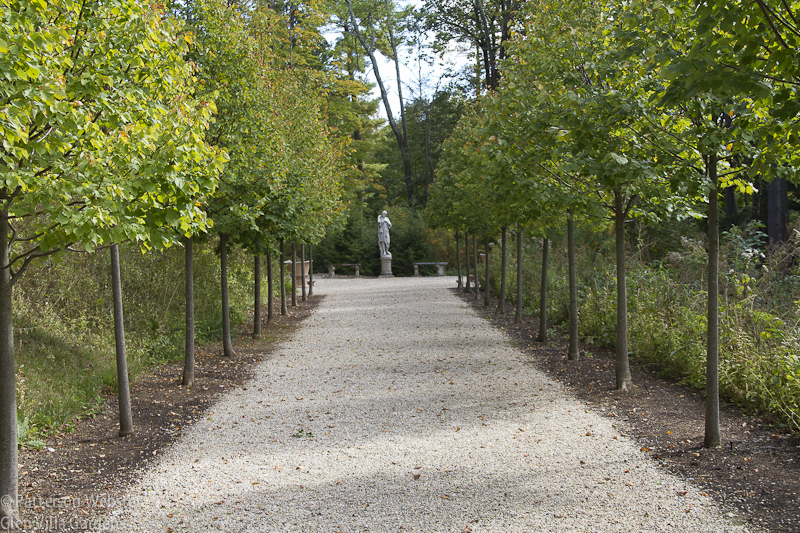
The statue “Diana Robing” is a replica of the one placed there by Mabel Choate’s mother. It was recreated by Robert Shure of Skylight Studios in Woburn, who was once a student of the original statue’s sculptor, Archangelo Cascieri.
Traditional sculpture is also used in traditional ways at The Mount, Edith Wharton’s home in Lenox, Massachusetts. Urns sit beside the staircase that leads to the garden. Spouting dolphins serve as a centrepiece of the fountain in the French flower garden and spouting rocks do the same in the Italian walled garden.
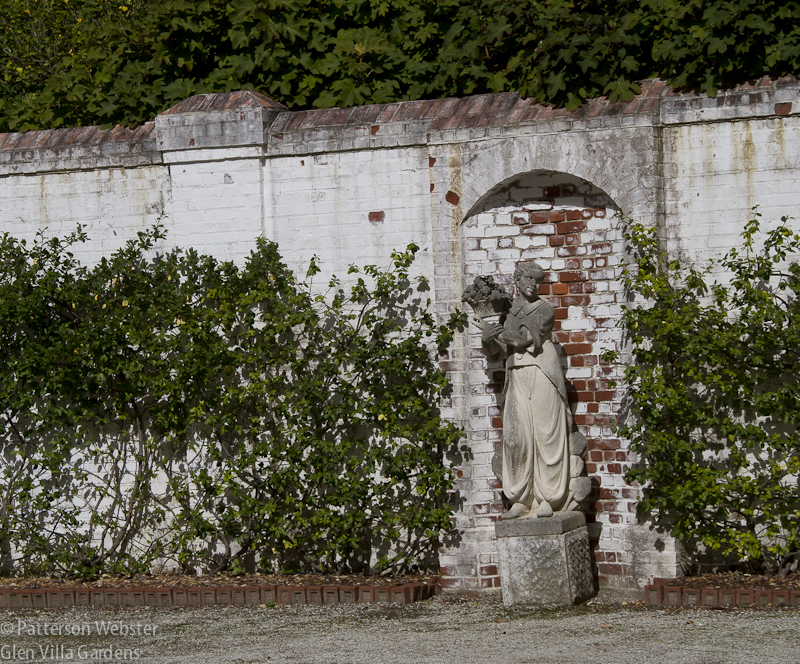
This fruitful goddess placed in the entry courtyard suits the architecture of Edith Wharton’s country house, The Mount.
Also at The Mount now is a temporary sculpture exhibition that includes several dozen sculptures by different artists displayed throughout the 50-acre grounds. Having visited The Mount several years ago, I probably would not have returned but this exhibition, subtitled Sculpture, Culture & Nature, drew me back.
Encouraging repeat visits was exactly what Susan Wissler, executive director of The Mount, hoped to accomplish: “Sculpture on the grounds provides our visitors a new way to view Edith Wharton‘s property.”
Well, yes and no. The open woods flanking the entry driveway are quite beautiful, particularly in those areas where vinca, or periwinkle, provides texture under stately trees. Some sculptures drew my attention to these trees and woods, others emphasized the contrast of open lawn.
Others, however, felt out of place, as uncomfortable in the setting as I would be in a whalebone corset. Consider this sculpture titled “Metro.” I liked the piece. I liked the colour, the movement, the sense of urban bustle it produced. But not when sited in a garden built in 1902.
Walking through the grounds at The Mount, I realized that for me an aesthetic response to a work of art is not enough. I want a sculpture to do more than look attractive. I want it to add something to the experience of being present in a particular place, at a particular time.
This may be an unfair way to judge sculptures that are installed temporarily. But I can’t deny that my desire for relevance influences how I respond to what I see. However appealing a sculpture is visually, unless it conveys an idea that relates to the site itself, or to something that happened there, or to the garden designer’s ideas — in this case, to Wharton’s ideas about architecture and design — for me it falls short.
You could argue that “Metro” is meant to be seen in relation to the house and to the French flower garden in order to create tension between now and then. You could argue that the location mirrors Wharton’s writings that broke with societal norms. But for me the jarring effect didn’t contribute to an enhanced experience of the site, its history or its role as a showplace for Wharton’s ideas about culture and the arts. The links the sculpture suggested were simply out of sync.
At Fruitlands Museum, about an hour west of Boston, I saw another temporary sculpture exhibition called Art in Nature. Fruitlands was an experimental utopian community founded in 1843 and led by Bronson Alcott and Charles Lane. Bronson Alcott, father of the author Louisa May Alcott, was a Transcendentalist. He and Lane came with their families to rural Massachusetts to put into practice their beliefs that people should be self-reliant, live independently and think for themselves. This meant adhering to a strictly vegan diet, refusing to use any animal products and rejecting products like cotton and molasses that were the result of slave labour. They named the commune Fruitlands to indicate that they intended to live off the fruit of the land. But since they were totally unskilled at farming, intellectuals who preferred talking to ploughing, their idealistic experiment failed.
At Fruitlands one sculpture expressed this history in a strikingly successful way. “Ladder to Fruitlands” was intriguing visually, but more significantly, it added meaning to the setting. It provoked thought, and not only about how the unsupported ladder was held erect.
Those of you who are regular readers of this blog know that I use sculpture in my garden, Glen Villa. Some sculptures are my own, some are made by others. I use art outdoors because I believe that it heightens and strengthens the impact of a space and helps to make a garden meaningful in a way that plants alone do not. (Since I also believe that the most successful private gardens are those with a personal stamp, I encourage others to use art to make their gardens distinctly their own.)
Looking at outdoor art as intensively as I’ve done this week, I’ve realized that a piece of sculpture, however visually pleasing it may be, is successful for me only when it relates to its setting both aesthetically and in terms of its meaning and intent. When it unites these things, my aesthetic response is heightened; I look more carefully at links between the sculpture’s lines and forms and those of the garden around it. My intellectual response is called into play as I consider how the ideas and concepts of the sculpture relate to the world outside the garden walls. A sculpture that combines these things for me takes a garden to a higher level, to something beyond itself.
At the DeCordova Museum in Lincoln, Massachusetts, one sculpture achieved this in full. Titled “Tower,” the sculpture falls across green grass, its black steel ribs twisted and contorted like a wounded animal.
Seeing it, who could fail to make a connection to the Twin Towers, or if not to that specific event, to the collapse of a symbol of financial power and authority? Yet along with a sense of loss, the piece produced a sense of joy and playfulness as children made their way gingerly through the innards of the beast.
Near the sculpture was a grove of pine trees. The area was beautiful in itself, but seen in conjunction with “Tower” it became a cathedral with trees aligned like columns to form a processional pathway to another time.
At the Clark Art Institute in Williamstown, Massachusetts, a recent installation by the German artist Thomas Schütte raised sculpture to a high level, in actual as well as metaphoric terms. “Crystal” sits atop a hillside with views onto the museum below and the town beyond. Seemingly simple, the wooden building is a blow-up of the structure of a crystal. It has no right angles. Backing onto green woods, it almost glistens in its purity.
The workmanship was wonderful, with no signs of one piece of wood joining another. This absence of joints created an interior that was extraordinarily smooth. Running my hand over the surface, the wood felt cool and clear, like polished crystal itself.
At odds with this uniformity was the outlook onto the field beyond, where contrast seemed all: from smooth interior surfaces to the rough textures of nature, from dim light to bright sunshine, from enclosed space to open air. Best of all, though, was how the view was defined, the crystalline structure creating an asymmetry that focused on the beauties of the natural landscape beyond. Aesthetics and meaning combined.
I am full of admiration for the sculptures created by Sosnowska and Schütte. I cannot hope to achieve work of this quality. But since I’m always looking for sculptural ideas to make my own, one piece that I saw stands out. It has none of the technical elegance of Schütte’s “Crystal,” none of the power of Sosnowska’s “Tower.” And despite its title, “Cognito,” it has none of the inherent meaning of Gianna Stewart’s “Ladder to Fruitlands.” Nonetheless, of all the pieces I saw this week, William Carlson’s installation at The Mount was the most inspirational.
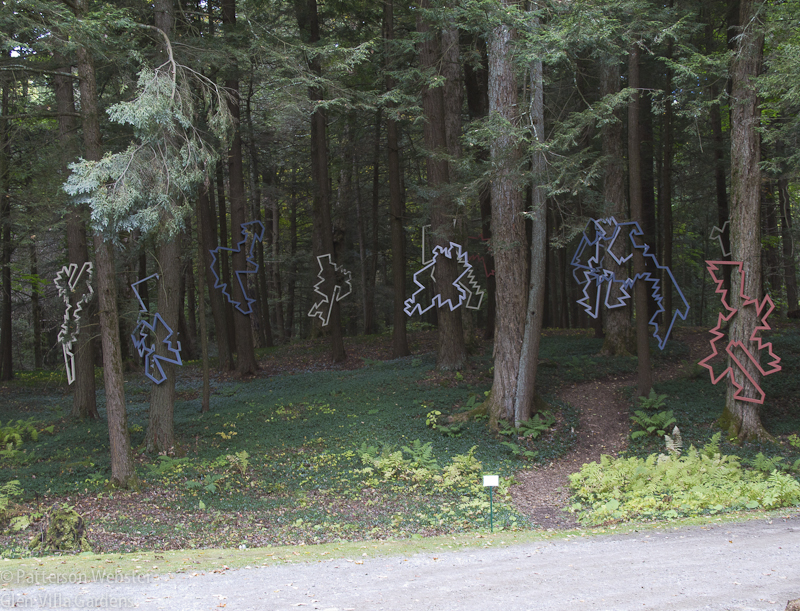
“Cognito” by William Carlson. Seeing these odd shapes, my politically conscious husband immediately identified them as gerrymandered electoral districts.
Positioned near a path that led into the woods, the forms drew me in. I had to follow the path, had to be under the trees that held these painted shapes. I was intrigued by the way their irregular angles contrasted with the regularity of the tree trunks. I didn’t think of electoral boundaries as my politically conscious husband did. I didn’t think of anything in particular. But I kept being drawn into the space.
Since seeing “Cognito” I’ve been working on an idea for a piece of sculpture to be located in a similar setting, a place where softwood trees have replaced the hardwoods that used to grow there. The installation will use shapes abstracted from nature to make a connection to a past that no longer exists. It will be a piece that speaks about loss without being nostalgic; I hope it will also bring joy.
I’m excited at the prospect of creating something new. I hope it will work.


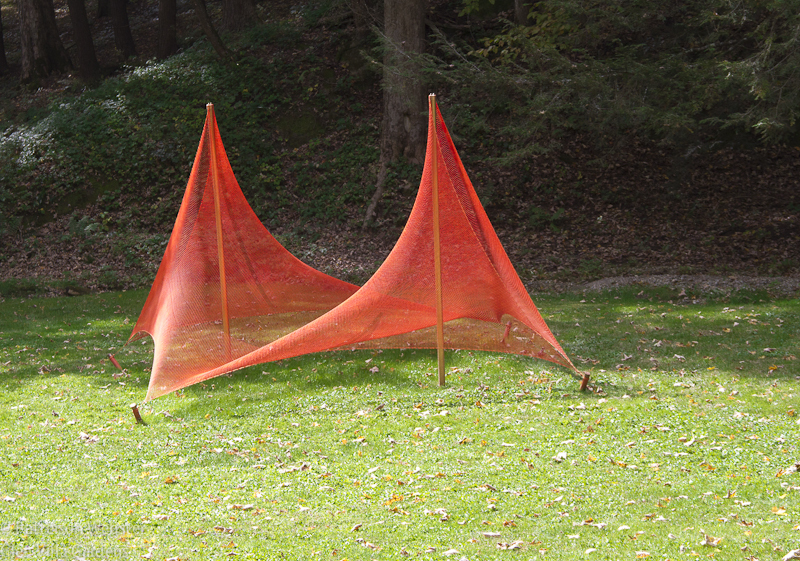
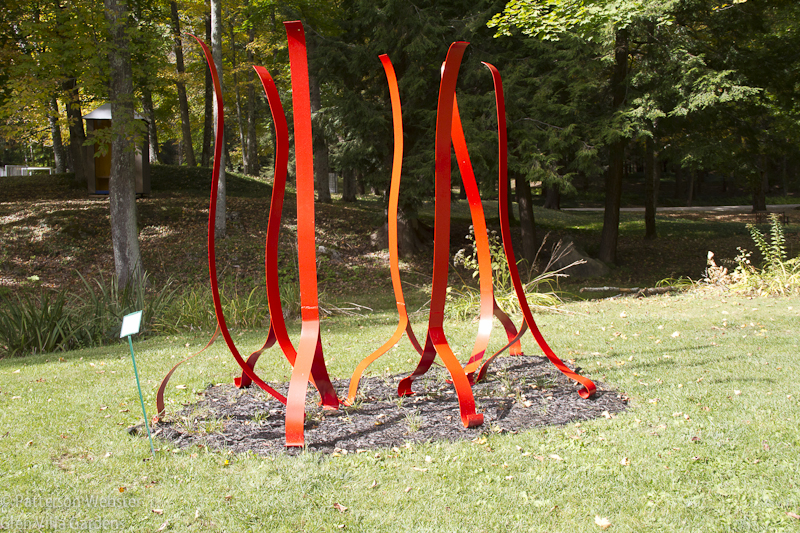
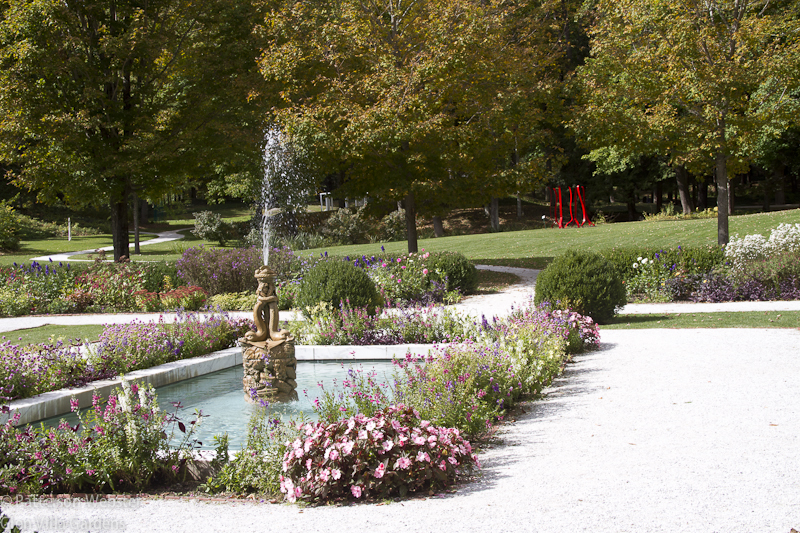
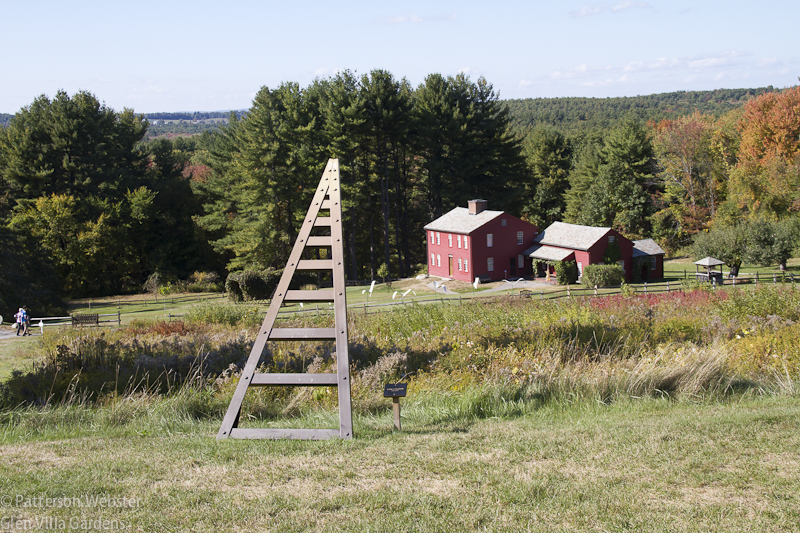
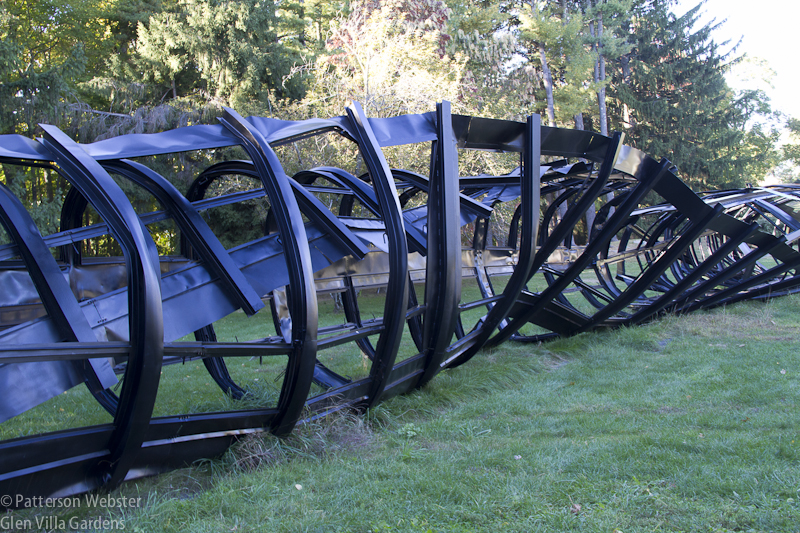

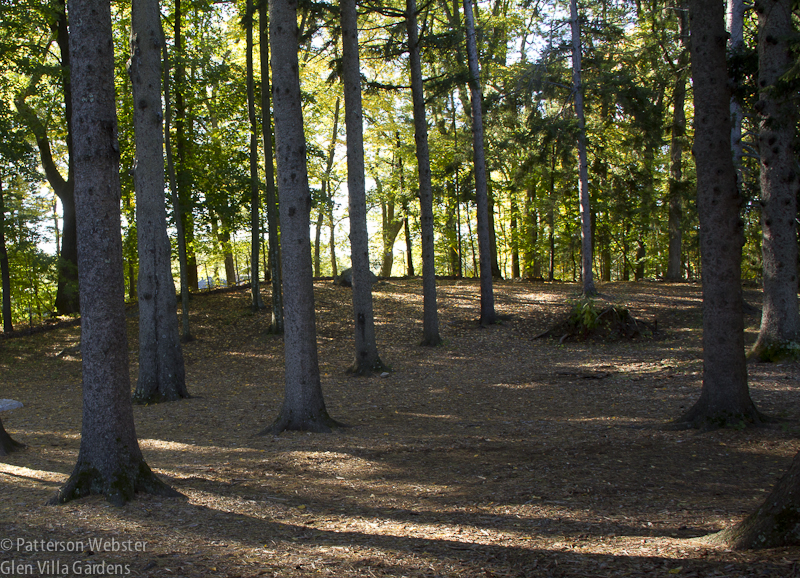
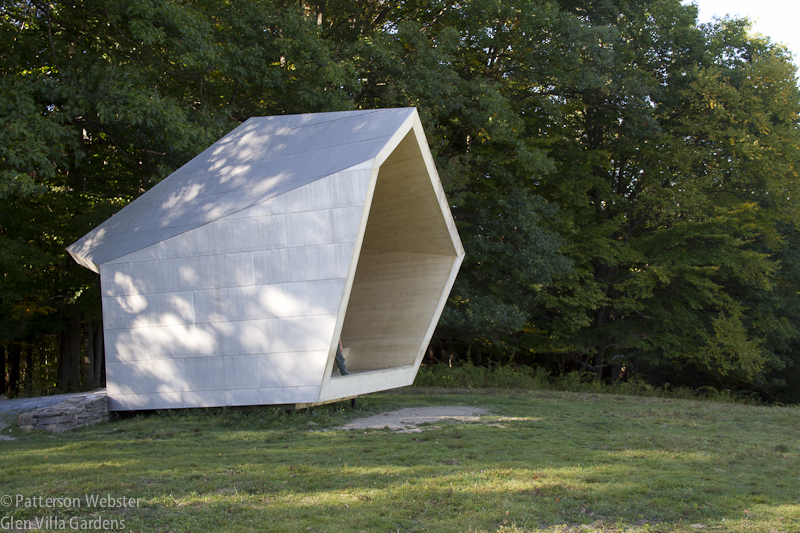
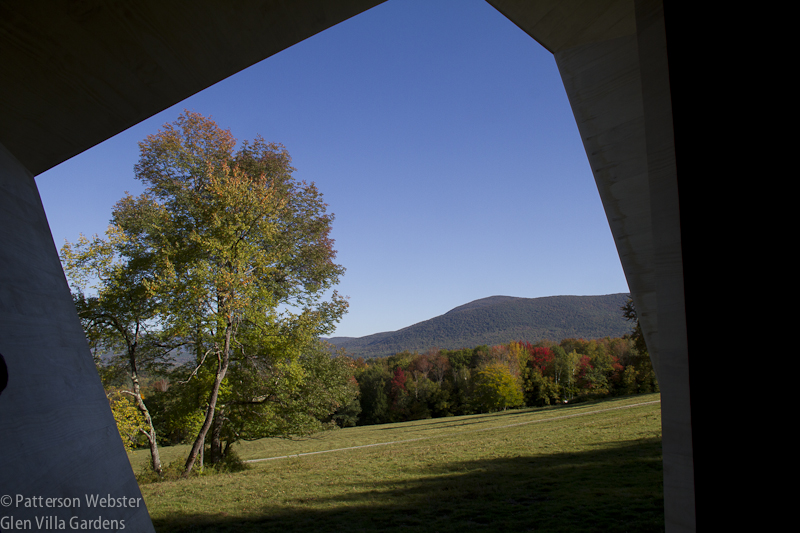




Yes, the picture of the grove of pines, creates an enchanted forest for me too!
Lots of potential enchantment in the pines.
Love ‘Cognito’ and am looking forward to seeing what it inspires you to create at Glen Villa. The apple ladder without an apple tree is a wonderfully sardonic commentary on the unrealistic farming goals of the Fruitlands intellectuals. Thanks for sharing both these sculptures and your analysis of how they work (or not) in their settings.
Jean, I started planning the new work on the weekend. It will take a full year before I can install it but I’m truly excited by the idea. I also loved the ladder. There were some other interesting pieces at Fruitlands as well. It’s thanks to my Boston-based daughter that I heard about the place — it was brand new to me.
I have to say, a lot of modern sculpture leaves me fairly cold. But it is a treat to see it through your eyes, Pat, and see some of what I am missing. I really like the ladder at Fruitlands; it had me laughing out loud. I am glad that children are allowed to crawl through the tower. At Crown Fountain in Chicago, the artist Jaume Plensa was surprised that children wanted to play in the waterscape that he created, which I thought showed his lack of imagination and understanding of the setting of his piece in a public park. Crown Fountain is a success precisely because it is crowded with people and children splashing.
Jason and I had a good laugh about Norman seeing gerrymandered districts; that sounds like something we would say!
As someone who travels across the US a lot, I see so much land that has been totally homogenized — shopping malls and housing developments that could be plunked down just about anywhere. Outside of some limited number of famous spaces, it’s becoming a radical endeavor to ask people to think about the history and culture and ecology of a particular location.
Judy, the homogenized landscape is an unfortunate reality of so many places. Locally roads are being widened and hillsides blasted to make the roads straighter with fewer ups and downs. The road may be marginally safer but traffic will certainly move faster and that may lead to more accidents. But what I most object to is the loss of the curves and bumps that made one road different from another. Finding places where sculpture reminds us of the past created some special memories.